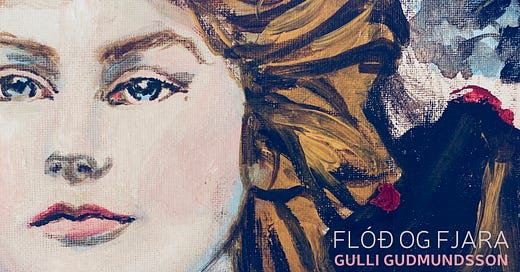YouTube: https://youtube.com/playlist?list=OLAK5uy_lhsglssFWg83WeiAG0LzvybwWon17eC0s&si=dCxWcLQ961fnucBi
Qobuz: https://open.qobuz.com/album/da5yls5w9ilgb
Tidal: https://tidal.com/browse/album/399025739?u
CD at Challenger Records (label): https://www.challengerecords.com/products/17290004918699/flod-og-fjara (There is also more info about the trio, here.)
The distinctive timbre of Scandinavian trumpet or piccolo trumpet is what marks this album first of all in my mind. Koen Smits, on trumpet, takes an approach like those of Arve Henriksen (piccolo trumpet) and Hildegunn Øiseth (trumpet). This signature style is breathy and soft, with hardly any, if any, attack to the notes. The trumpet, piano and bass jazz trio are led by Gulli Gudmundsson on double bass. Jeroen van Vliet plays a generally gentle piano, which gets more intense and chromatic in “Glíma,” track three, where some electronic processing, of both the trumpet and the piano, appears to be added to the mix.
According to Discogs.com, Gudmundssonn has been in many ensembles, including the following: Binary Orchid, Christian Kappe - Florian Zenker Quartett, Duveltjeskermis, Gatecrash (4), Laetitia Van Krieken Big Bang, Kristina Fuchs Sonic Quintet, Kristina Fuchs Sonic Unit, Natasza Kurek Group, The Vansina Verbruggen Gudmundsson Trio, Wolfert Brederode Trio, Wolfert Brederode-Eric Ineke Quintet, Yuri Honing Acoustic Quartet. Gudmundsson’s bass is deep, round, and gentle, though strong. He drops out for the beginning of “Panta,” track five, allowing van Vliet’s piano to take the lead. “Panta”’s early minutes include prominent electronic processing of Smits’ trumpet, adding a long reverb effect. The middle of “Panta” features all three players in unison. The ending brings back electronic processing of Smits’ trumpet. There is also a subtle synthesizer part that seems independent of the piano, trumpet, and bass.
“Alcañiz” is a cheery, I would say “New Age” styled, track that stands out as the most front-and-center sounding piece on the album. This is probably attributable to the piano stylings on the track. It is followed by a driving rhythm in “Sólveig,” which name may be a reference to Edvard Grieg’s character of the same name, in Peer Gynt; or, it may be a reference tracing back to Gudmundsson’s youth and origin in Iceland, to a “legend of Sólveig” (https://mysticiceland.com/the-legend-of-solveig/).
The final track, “Komdu Heim,” is a meditative piece, with flurries of breathy notes by Smit and sparse accompaniment by van Vliet. Gudmundsson takes a background role. The fade out is a processed trumpet and perhaps backwards, processed piano, a cycling of only a couple of notes.
This album inspires me to pick up the trumpet again and learn how to imitate the tone of Smit, Henriksen, and Øiseth.





